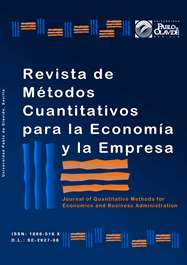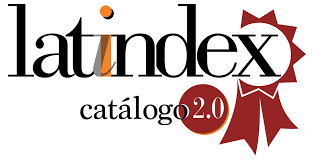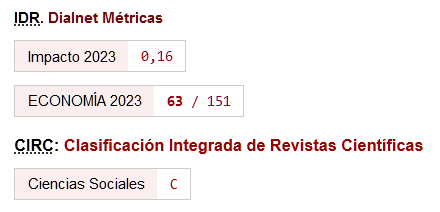Business confidence indicator in the construction sector in Mexico through a fuzzy inference system
DOI:
https://doi.org/10.46661/revmetodoscuanteconempresa.5976Keywords:
fuzzy inference system, fuzzy logic, fuzzy rules, linguistic variable, Mamdani, Likert scaleAbstract
In Mexico the National Institute of Statistic and Geography (INEGI) publishes a monthly indicator of business confidence (ICE) for various economic sectors using the Monthly Survey of Business Opinion (EMOE). In the present work reference is made only to the construction segment as it is one of the most sensitive sectors for the growth of the economy in Mexico. The official information issued by the INEGI about the ICE for this sector, is the result of the simple arithmetic mean of five qualitative indicators already projected and weighted. When applying the arithmetic mean at the end of the process to obtain an indicator of such importance, gives rise to the classic debate of applying this descriptive statistic in mean qualitative variables in Likert type questions. To overcome this problem, it is proposed to take the labels used in the answer options of the questions used in the EMOE questionnaire, to linguistic variables, where through the methodology of fuzzy inference systems, a Fuzzy Business Confidence Indicator (ICED) is obtained as a result. To validate the proposed system, the new fuzzy confidence indicators were calculated from January 2012 to February 2021 and compared to the official figures issued by the INEGI, obtaining similar results with the advantage that the indicators derived by the system, turned out to be higher or lower in general. What allows this path is to be more sensitive to changes in opinion among entrepreneurs, avoiding centralizing opinions by using the simple arithmetic mean.
Downloads
References
Adekoya, O.B., & Oliyide, J.A. (2021). Business confidence as a strong tracker of future growth: is it driven by economic policy uncertainty and oil price shocks in the OECD countries? Future Business Journal, 7(1), 1-13. https://doi.org/10.1186/s43093-021-00103-7
Arango, M.D., Serna, C.A., & Pérez, G. (2012). La gestión de indicadores empresariales con lógica difusa para la toma de decisiones. Lámpsakos, 8 (1), 47-53. https://www.funlam.edu.co/revistas/index.php/lampsakos/article/view/678/650
Banco de México (2019). Informe trimestral enero-marzo 2019. https://www.banxico.org.mx/publicaciones-y-prensa/informes-trimestrales/%7B970DDE85-9C2D-BF98-570A-D1266B1144C9%7D.pdf
Bandiera, L. (2002, diciembre). The Role of Business Confidence Indicators in the International Interdependencies between Germany and the United States. (Kiel Advanced Studies Working Paper No. 398) https://papers.ssrn.com/sol3/papers.cfm?abstract_id=1078918
Carnazza, P., &Parigi, G. (2003). Tentative business confidence indicators for the Italian economy. Journal of Forecasting, 22(8), 587-602. https://doi.org/10.1002/for.878
Chimi, C.J., & Russell, D.L. (Noviembre 8, 2009). The Likert scale: A proposal for improvement using quasi-continuous variables. [Sesión de conferencia] Information Systems Education Conference, Washington, DC.
Cruz, A., & Alarcón, A.D. (2017). La lógica difusa en la modelización del riesgo operacional. Una solución desde la inteligencia artificial en la banca cubana. Cofin Habana, 11(2), 122-135. http://www.cofinhab.uh.cu/index.php/RCCF/article/view/232
De Lucio, J., & Valero, M. (2009). El Indicador de Confianza Empresarial de las Cámaras de Comercio. Índice: revista de estadística y sociedad, 32, 14-17. http://www.revistaindice.com/numero32/p14.pdf
Demirel, S.K., & Artan, S. (2017). The causality relationships between economic confidence and fundamental macroeconomic indicators: Empirical evidence from selected European Union countries. International Journal of Economics and Financial Issues, 7(5), 417-424. https://econjournals.com/index.php/ijefi/article/view/5356
Diciembre, S. (2017). Sistemas de Control con Lógica Difusa: Métodos de Mamdani y de Takagi-Sugeno-Kang (TSK). [Tesis de Grado. Universitat Jaume I]. Repositori Universitat Jaume I. http://repositori.uji.es/xmlui/handle/10234/173788
D´Negri, C.E., & De Vito, E. L. (2006). Introducción al razonamiento aproximado: lógica difusa. Revista Americana de Medicina Respiratoria, 6(3), 126-136. https://www.redalyc.org/pdf/3821/382138367007.pdf
Enciso, M., Acosta, A., & Campo, J. (2013). Sistema de inferencia difuso para la inflación en Colombia. Ensayos sobre Política Económica, 31(71), 73-84. http://www.scielo.org.co/pdf/espe/v31n71/v31n71a5.pdf
Encuesta Mensual de Opinión Empresarial (EMOE) (2019). EMOE: síntesis metodológica: serie 13: Encuestas Económicas Nacionales. Instituto Nacional de Estadística y Geografía, México: INEGI https://www.inegi.org.mx/contenidos/productos/prod_serv/contenidos/espanol/bvinegi/productos/nueva_estruc/702825109110.pdf
Flores, L., & Camarena, M. (2013). Evaluación de programas públicos en el marco de la realidad social. Metodología basada en la lógica difusa como instrumento para el análisis de fenómenos sociales. Revista Latinoamericana de Metodología de la Investigación Social: ReLMIS, 5, 8-23. https://dialnet.unirioja.es/servlet/articulo?codigo=5275941
Flores, L., & Salas, I.A. (2015). Las brechas de género en la calidad del empleo en México. Una valoración basada en modelos de lógica difusa. Análisis Económico, XXX(75), 89-112. https://www.redalyc.org/pdf/413/41343702004.pdf
Gallardo, M., & Pedersen, M. CEPAL (2007). Indicadores líderes compuestos: resumen de metodologías de referencia para construir un indicador regional en América Latina. Santiago de Chile: Publicación de las Naciones Unidas. https://repositorio.cepal.org/handle/11362/4750
Gallardo, M., & Pedersen, M. CEPAL (2008). Encuesta de opinión empresarial del sector industrial en América Latina. Santiago de Chile: Publicación de las Naciones Unidas. https://repositorio.cepal.org/bitstream/handle/11362/4770/S0800468_es.pdf?sequence=1&isAllowed=y
González, C. (2015). Lógica difusa una introducción práctica, técnicas de Soft Computing. https://www.esi.uclm.es/www/cglez/downloads/docencia/2011_Softcomputing/LogicaDifusa.pdf
Guzmán, D., & Castaño, V.M. (2006). La lógica difusa en ingeniería: principios, aplicaciones y futuro. Revista de Ciencia y Tecnología, 24(2), 87-107. https://revistas.ucr.ac.cr/index.php/cienciaytecnologia/article/view/2640/2591
Hesketh, B., Pryor, R., Gleitzman, M., & Hesketh, T. (1988). Practical applications and psychometric evaluation of a computerised fuzzy graphic rating scale. Advances in Psychology, 56, 425-454. https://doi.org/10.1016/S0166-4115(08)60493-8
Hodge, D.R., & Gillespie, D. (2003). Phrase completions: An alternative to Likert scales. Social Work Research, 27(1), 45-55. https://www.researchgate.net/publication/234692602
INEGI (2019, 1 octubre). Indicadores de Confianza Empresarial: Cifras durante septiembre de 2019 [Comunicado de Prensa Número 477/19] https://www.inegi.org.mx/contenidos/saladeprensa/boletines/2019/ice/ice2019_10.pdf
INEGI (2020, 25 febrero). Producto interno bruto de México durante el cuarto trimestre de 2019 [Comunicado de Prensa Número 110/20] https://www.inegi.org.mx/contenidos/saladeprensa/boletines/2020/pib_pconst/pib_pconst2020_02.pdf
INEGI (2020, 6 julio). Indicador mensual de la inversión fija bruta en México durante abril de 2020 [Comunicado de Prensa Número 298/20] https://www.inegi.org.mx/contenidos/saladeprensa/boletines/2020/imfbcf/imfbcf2020_07.pdf
INEGI (2020, 23 julio). Indicadores de empresas constructoras: Cifras durante mayo de 2020 [Comunicado de Prensa Número 34420] https://www.inegi.org.mx/contenidos/saladeprensa/boletines/2020/enec/enec2020_07.pdf
INEGI (2021, 25 febrero). Producto interno bruto de México durante el cuarto trimestre de 2019 [Comunicado de Prensa Número 157/21] https://www.inegi.org.mx/contenidos/saladeprensa/boletines/2021/pib_pconst/pib_pconst2021_02.pdf
INEGI (2021, 1 julio). Indicadores de Confianza Empresarial: Cifras durante junio de 2021 [Comunicado de Prensa Número 365/21] https://www.inegi.org.mx/contenidos/saladeprensa/boletines/2021/ice/ice2021_07.pdf
Jamieson, S. (2004). Likert scales: How to (ab) use them? Medical Education, 38(12), 1217-1218. https://eprints.gla.ac.uk/59552/1/59552.pdf
Joshi, A., Kale, S., Chandel, S.,& Pal, D. K. (2015). Likert scale: Explored and explained. British Journal of Applied Science & Technology, 7(4), 396-403. https://www.researchgate.net/publication/276394797_Likert_Scale_Explored_and_Explained
Kaufmann, A., & Gil, J. (1993). Técnicas especiales para la gestión de expertos. Barcelona: Editorial Milladoiro.
Khan, H., & Upadhayaya, S. (2020). Does business confidence matter for investment?. Empirical Economics, 59(4), 1633-1665. https://doi.org/10.1007/s00181-019-01694-5
Kleynhans, E., & Coetzee, C. (2021). Regional Business Confidence as Early Indicator of Regional Economic Growth. Managing Global Transitions: International Research Journal, 19(1), 27-48. https://www.hippocampus.si/ISSN/1854-6935/19.27-48.pdf
Lalla, M., Facchinetti, G.,& y Mastroleo, G. (2005). Ordinal scales and fuzzy set systems to measure agreement: an application to the evaluation of teaching activity. Quality and Quantity, 38(5), 577-601. https://link.springer.com/article/10.1007/s11135-005-8103-6
Li, Q. (2013). A novel Likert scale based on fuzzy sets theory. Expert Systems with Applications, 40(5), 1609-1618. https://doi.org/10.1016/j.eswa.2012.09.015
Los, V., & Ocheretin, D. (2019). Construction of business confidence index based on a system of economic indicators. SHS Web of Conference, 65, 1-6. https://doi.org/10.1051/shsconf/20196506003
Phélan, M. (2011). Revisión de índices e indicadores de desarrollo: aportes para la medición del buen vivir (sumak kawsay). Obets: Revista de Ciencias Sociales, 6(1), 69-95. https://dialnet.unirioja.es/servlet/articulo?codigo=3796300
Mamdani, E.H. (1977). Application of fuzzy logic to approximate reasoning using linguistic synthesis. IEEE Computer Architecture Letters, 26(12), 1182-1191. https://ieeexplore.ieee.org/abstract/document/1674779
Martinez, N., Gómez, D., & Montero, J. (1-3 de febrero del 2012). Impacto de las etiquetas en la interpretación de la escala de Likert [Sesión de conferencia]. XVI Congreso Español sobre Tecnologías y Lógica Fuzzy, Valladolid, España, http://estylf2012.eii.uva.es/ActasESTYLF2012.pdf
Matas, A. (2018). Diseño del formato de escalas tipo Likert: un estado de la cuestión. Revista electrónica de investigación educativa, 20(1), 38-47. https://doi.org/10.24320/redie.2018.20.1.1347
Mazurek, J., Pérez, C., Fernández, C., Magnot, J.P., & Magnot, T. (2021). The 5-item Likert Scale and percentage scale correspondence with implications for the use of models with (fuzzy) linguistic variables. Revista de Métodos Cuantitativos para la Economía y Empresa, 31, 3-16. https://dx.doi.org/10.46661/revmetodoscuanteconempresa.4010
Medina, S. (2006). Estado de la cuestión acerca del uso de la lógica difusa en problemas financieros. Cuadernos de Administración, 19(32), 195-223. https://www.redalyc.org/pdf/205/20503209.pdf
Medina, S., & Paniagua, G. (2008). Modelo de inferencia difuso para estudio de crédito. DYNA: revista de la Facultad de Minas. Universidad Nacional de Colombia. Sede Medellín, 75(154), 215-229. https://dialnet.unirioja.es/servlet/articulo?codigo=7550614
Mendoza, L.A. (2009). Sistema de lógica difusa. Una aplicación a la percepción empresarial. Revista Universidad y Empresa, 11(17), 252-270. https://revistas.urosario.edu.co/index.php/empresa/article/view/1092/990
Nezinský, E., & Baláz, V. (2016). Are the Confidence Indicators Meaningful for Forecasting Real Economy? 1: Testing Power of Confidence Indicators for Industry Output, Prices and Employment in the Visegrád Group Countries. Ekonomicky casopis, 64(10), 923-936. https://www.proquest.com/docview/1864074613?pq-origsite=gscholar&fromopenview=true
Santero, T., & Westerlund, N. Organisation for Economic Co-operation and Development (1996). Confidence Indicators and Their Relationship to Changes in Economic Activity. OECD Economics Department Working Papers, No. 170, OECD Publishing, Paris. https://www.oecd-ilibrary.org/content/paper/537052766455?crawler=true
Siegrist, M., Gutscher, H., & Earle, T.C. (2005). Perception of risk: the influence of general trust, and general confidence. Journal of Risk Research, 8(2), 145-156. https://www.tandfonline.com/doi/abs/10.1080/1366987032000105315
Soto, A.M., & Medina, S. (2004). Desarrollo de un sistema de inferencia difuso para la evaluación de crédito por parte de una empresa prestadora de servicios. Dyna, 71(143), 25-36. https://www.redalyc.org/pdf/496/49614303.pdf
Stevens, S.S. (1946). On the theory of scales of measurement. Science AAAS, 103(2684), 677-680. https://psychology.okstate.edu/faculty/jgrice/psyc3120/Stevens_FourScales_1946.pdf
Vonglao, P. (2017). Application of fuzzy logic to improve the Likert scale to measure latent variables. Kasetsart Journal of Social Sciences, 38(3), 337-344. https://doi.org/10.1016/j.kjss.2017.01.002
Willits, F. K., Theodori, G. L., & Luloff, A. E. (2016). Another look at Likert scales. Journal of Rural Social Sciences, 31(3), 126-139. https://egrove.olemiss.edu/cgi/viewcontent.cgi?article=1073&context=jrss
Wu, H., & Leung, S. O. (2017). Can Likert scales be treated as interval scales? A Simulation study. Journal of Social Service Research, 43(4), 527-532. https://doi.org/10.1080/01488376.2017.1329775
Zadeh, L.A. (1965). Fuzzy Sets. Information and Control, 8(3), 338-353. https://doi.org/10.1016/S0019-9958(65)90241-X
Zadeh, L. A. (1975). The concept of a linguistic variable and its application to approximate reasoning-I. Information sciences, 8(3), 199-249. https://doi.org/10.1016/0020-0255(75)90036-5
Downloads
Published
How to Cite
Issue
Section
License

This work is licensed under a Creative Commons Attribution-ShareAlike 4.0 International License.
Submission of manuscripts implies that the work described has not been published before (except in the form of an abstract or as part of thesis), that it is not under consideration for publication elsewhere and that, in case of acceptance, the authors agree to automatic transfer of the copyright to the Journal for its publication and dissemination. Authors retain the authors' right to use and share the article according to a personal or instutional use or scholarly sharing purposes; in addition, they retain patent, trademark and other intellectual property rights (including research data).
All the articles are published in the Journal under the Creative Commons license CC-BY-SA (Attribution-ShareAlike). It is allowed a commercial use of the work (always including the author attribution) and other derivative works, which must be released under the same license as the original work.
Up to Volume 21, this Journal has been licensing the articles under the Creative Commons license CC-BY-SA 3.0 ES. Starting from Volume 22, the Creative Commons license CC-BY-SA 4.0 is used.










